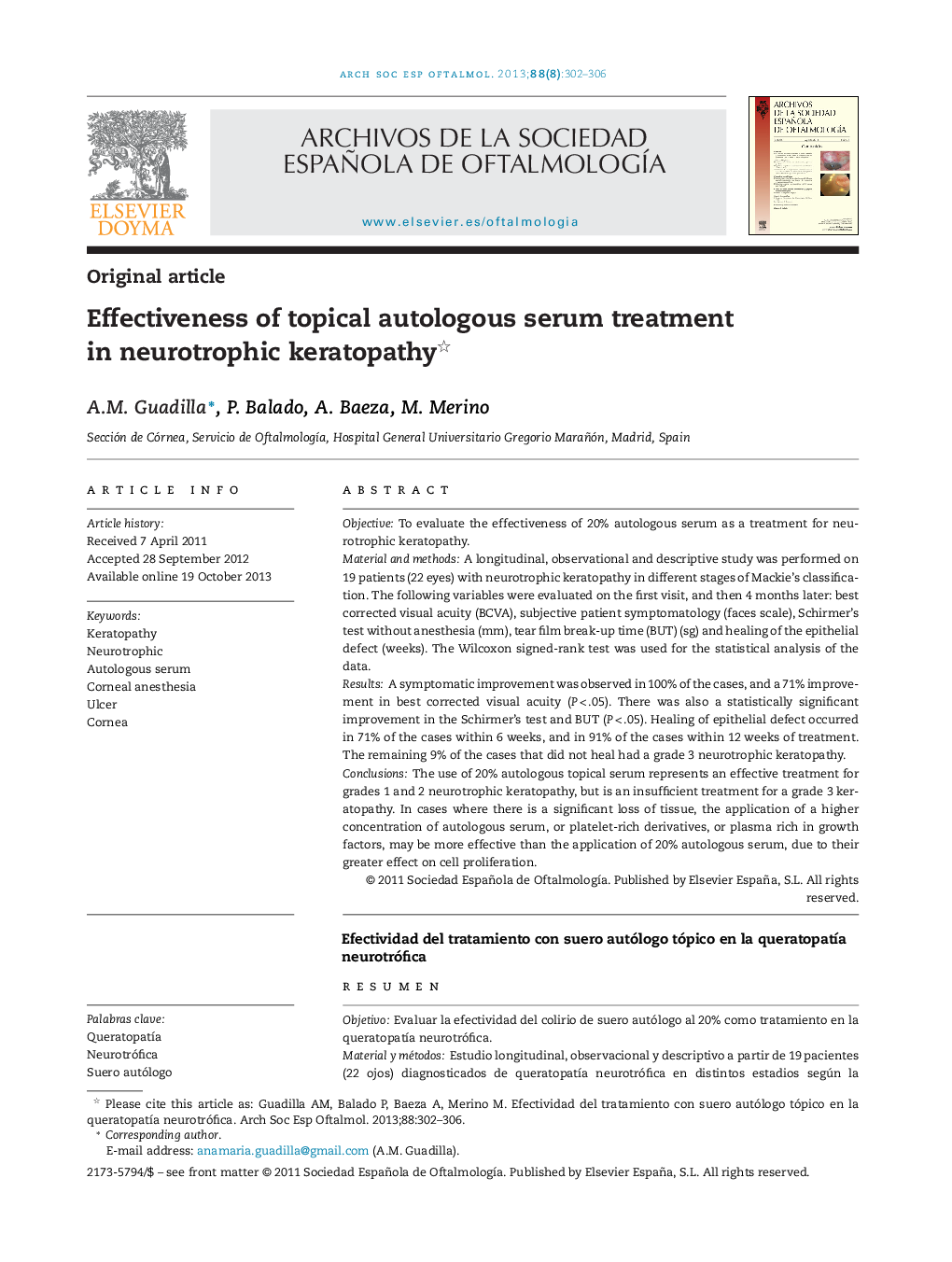| کد مقاله | کد نشریه | سال انتشار | مقاله انگلیسی | نسخه تمام متن |
|---|---|---|---|---|
| 4008642 | 1260892 | 2013 | 5 صفحه PDF | دانلود رایگان |

ObjectiveTo evaluate the effectiveness of 20% autologous serum as a treatment for neurotrophic keratopathy.Material and methodsA longitudinal, observational and descriptive study was performed on 19 patients (22 eyes) with neurotrophic keratopathy in different stages of Mackie's classification. The following variables were evaluated on the first visit, and then 4 months later: best corrected visual acuity (BCVA), subjective patient symptomatology (faces scale), Schirmer's test without anesthesia (mm), tear film break-up time (BUT) (sg) and healing of the epithelial defect (weeks). The Wilcoxon signed-rank test was used for the statistical analysis of the data.ResultsA symptomatic improvement was observed in 100% of the cases, and a 71% improvement in best corrected visual acuity (P < .05). There was also a statistically significant improvement in the Schirmer's test and BUT (P < .05). Healing of epithelial defect occurred in 71% of the cases within 6 weeks, and in 91% of the cases within 12 weeks of treatment. The remaining 9% of the cases that did not heal had a grade 3 neurotrophic keratopathy.ConclusionsThe use of 20% autologous topical serum represents an effective treatment for grades 1 and 2 neurotrophic keratopathy, but is an insufficient treatment for a grade 3 keratopathy. In cases where there is a significant loss of tissue, the application of a higher concentration of autologous serum, or platelet-rich derivatives, or plasma rich in growth factors, may be more effective than the application of 20% autologous serum, due to their greater effect on cell proliferation.
ResumenObjetivoEvaluar la efectividad del colirio de suero autólogo al 20% como tratamiento en la queratopatía neurotrófica.Material y métodosEstudio longitudinal, observacional y descriptivo a partir de 19 pacientes (22 ojos) diagnosticados de queratopatía neurotrófica en distintos estadios según la clasificación de Mackie. Las variables evaluadas, tanto en la primera visita como a los 4 meses de seguimiento, fueron: agudeza visual mejor corregida, sintomatología subjetiva del paciente (escala de caras), test de Schirmer sin anestesia (mm), tiempo de rotura de la película lagrimal (BUT) (sg) así como el tiempo de curación del defecto epitelial (semanas). Para el análisis estadístico de los datos empleamos la prueba de rangos de Wilcoxon.ResultadosSe observó una mejoría sintomática en el 100% de los casos y del 71% en la agudeza visual mejor corregida, siendo ambas mejorías estadísticamente significativas. También observamos una mejoría en el test de Schirmer y en el BUT, pero estas no fueron estadísticamente significativas. La curación del defecto epitelial fue en el 71% de los casos antes de 6 semanas de tratamiento y en el 91% antes de las 12 semanas. El 9% restante, que no presentó curación, correspondía a queratopatías neurotrópicas en estadio 3.ConclusionesEl colirio de suero autólogo al 20% representa un tratamiento efectivo en las queratopatías neurotróficas grados 1 y 2, siendo un tratamiento insuficiente en las queratopatías de grado 3. En estos casos, en los que existe una importante pérdida tisular, la aplicación de suero autólogo a una mayor concentración, o de los derivados plaquetarios o del plasma rico en factores de crecimiento, podría resultar más efectiva que la aplicación de suero autólogo al 20%, debido a su mayor efecto sobre la proliferación celular.
Journal: Archivos de la Sociedad Española de Oftalmología (English Edition) - Volume 88, Issue 8, August 2013, Pages 302–306